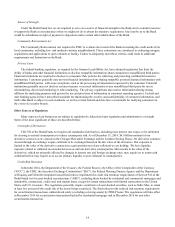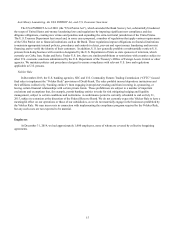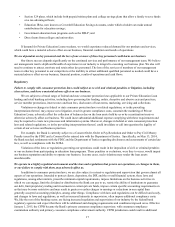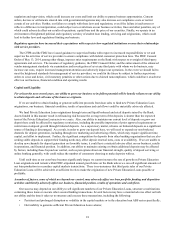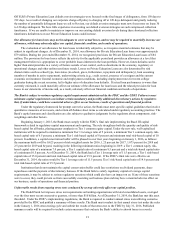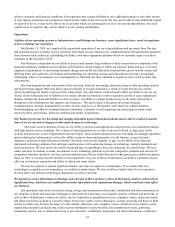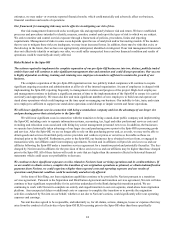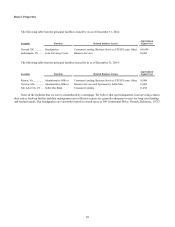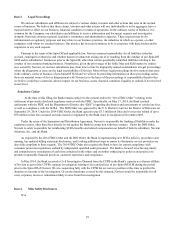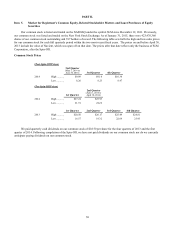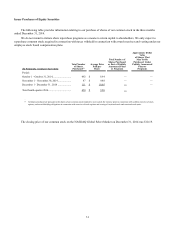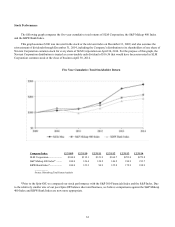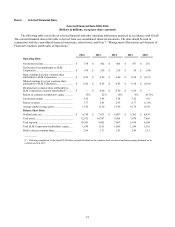Sallie Mae 2014 Annual Report Download - page 25
Download and view the complete annual report
Please find page 25 of the 2014 Sallie Mae annual report below. You can navigate through the pages in the report by either clicking on the pages listed below, or by using the keyword search tool below to find specific information within the annual report.disrupt our or our customers’ or other third parties’ business operations. Moreover, information security risks for large financial
institutions have generally increased in recent years in part because of the proliferation of new technologies, the use of the
Internet and telecommunications technologies to conduct financial transactions, and the increased sophistication and activities
of organized crime, hackers, terrorists, activists, and other external parties.
If one or more of such events occur, personal, confidential and other information processed and stored in, and transmitted
through our computer systems and networks, or those of third party vendors, could be jeopardized or could cause interruptions
or malfunctions in our operations that could result in significant losses or reputational damage. We also routinely transmit and
receive personal, confidential and proprietary information, some through third parties. We have put in place secure transmission
capability, and work to ensure third parties follow similar procedures. An interception, misuse or mishandling of personal,
confidential or proprietary information being sent to or received from a customer or third party could result in legal liability,
regulatory action and reputational harm. In the event personal, confidential or other information is jeopardized, intercepted,
misused or mishandled, we may be required to expend significant additional resources to modify our protective measures or to
investigate and remediate vulnerabilities or other exposures, and we may be subject to fines, penalties, litigation costs and
settlements and financial losses that are either not insured against or not fully covered through any insurance maintained by us.
If one or more of such events occur, our business, financial condition or results of operations could be significantly and
adversely affected.
We increasingly depend on third parties for a wide array of services, systems and information technology applications, and a
breach of service levels, or violation of law by one of these third parties could disrupt our business or provide our
competitors with an opportunity to enhance their position at our expense.
We increasingly depend on third parties for a wide array of services, systems and information technology applications.
Third-party vendors are significantly involved in aspects of our software and systems development, the timely and secure
transmission of information across our data communication network, and for other telecommunications, processing, remittance
and technology-related services in connection with our business. If a service provider fails to provide the services we require or
expect, or fails to meet applicable contractual or regulatory requirements, such as service levels or compliance with applicable
laws, the failure could negatively impact our business by adversely affecting our ability to process customers’ transactions in a
timely and accurate manner, otherwise hampering our ability to serve our customers, or subjecting us to litigation and
regulatory risk for matters as diverse as poor vendor oversight or improper release or protection of personal information. Such a
failure could adversely affect the perception of the reliability of our networks and services, and the quality of our brands, and
could materially adversely affect our revenues and/or our results of operations.
We may face risks related to litigation that could result in significant legal expenses and settlement or damage awards.
Navient has agreed to be responsible, and indemnify us, for all claims, actions, damages, losses or expenses that may
arise from the conduct of all activities of pre-Spin-Off SLM occurring prior to the Spin-Off other than those specifically
excluded in the Separation and Distribution Agreement, including the settlement or damage awards and legal expenses
associated with any litigation arising from most of our pre-Spin-Off activities. Consequently, due to Navient’s indemnification
and the smaller, relatively younger vintages of our Private Education Loans, over the near term our litigation-related expenses
may be lower than might otherwise be expected. As our business grows, we will likely be subject to claims and litigation,
which could seriously harm our business and require us to incur significant costs. We are also generally obligated, to the extent
permitted by law, to indemnify our current and former officers and directors who are named as defendants in these lawsuits.
Defending against litigation may require significant attention and resources of management and, regardless of the outcome,
such litigation could result in significant legal expenses. If we are a party to material litigation and if the defenses we assert are
ultimately unsuccessful, or if we are unable to achieve a favorable settlement, we could be liable for large damages and that
could have a material adverse effect on our business, results of operations and financial position. Likewise, similar material
adverse effects could occur if Navient is unwilling or unable to honor its indemnification obligations under the Separation and
Distribution Agreement.
Incorrect estimates and assumptions by management in connection with the preparation of our consolidated financial
statements could adversely affect the reported assets, liabilities, income and expenses.
The preparation of our consolidated financial statements requires management to make critical accounting estimates and
assumptions that affect the reported amounts of assets, liabilities, income and expenses during the reporting periods. Incorrect
estimates and assumptions by management in connection with the preparation of our consolidated financial statements could
adversely affect the reported amounts of assets and liabilities and the reported amounts of income and expenses. A description
of our critical accounting estimates and assumptions may be found in Part I, Item 7. “Management’s Discussion and Analysis of
Financial Condition and Results of Operations - Critical Accounting Policies and Estimates” and in Note 2, “Significant
Accounting Policies” to the consolidated financial statements included in this Form 10-K. If we make incorrect assumptions or
23



